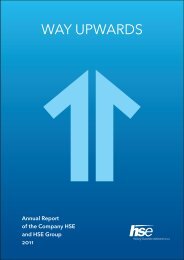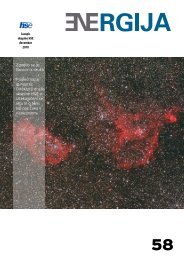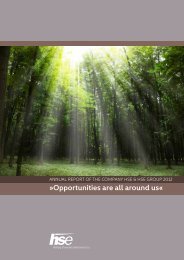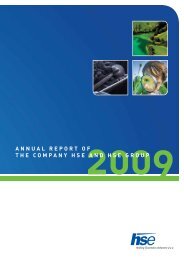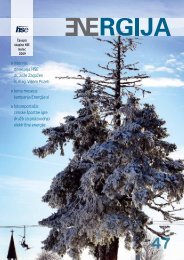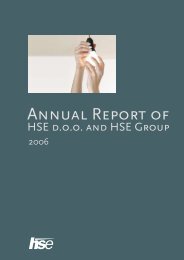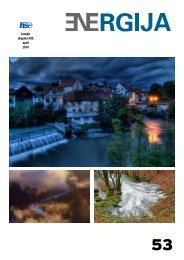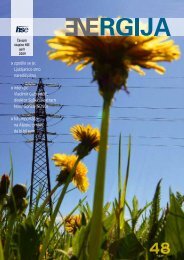ANNUAL REPORT - HSE
ANNUAL REPORT - HSE
ANNUAL REPORT - HSE
Create successful ePaper yourself
Turn your PDF publications into a flip-book with our unique Google optimized e-Paper software.
nomic benefits expected on the basis of the originally<br />
assessed standard of performance of the assets are<br />
recognised as expenses when incurred.<br />
The difference between the net sales value and the<br />
carrying amount of a disposed of item of property,<br />
plant and equipment is transferred to revaluation operating<br />
revenue or expenses.<br />
Property, plant and equipment items intended for sale<br />
are recorded as current assets intended for sale.<br />
An item of property, plant and equipment is depreciated<br />
using the straight-line depreciation method over<br />
its expected useful life. Depreciation is accounted for<br />
individually since the first day of the following month<br />
after an item of property, plant and equipment has<br />
been available for use. The depreciation charge for<br />
the current year is recorded as an operating expense<br />
for the year. The residual value of property, plant and<br />
equipment has not been determined.<br />
On initial recognition, long-term investments are recorded<br />
at their historical cost plus the costs directly<br />
attributable to the investment.<br />
In the books of account of group companies, long-term<br />
investments are recognised based on their settlement<br />
date (payment date).<br />
After initial recognition, long-term investments are<br />
carried at cost in companies’ books of account (which<br />
also includes investments in subsidiaries and associates)<br />
and are recorded as available-for-sale financial<br />
assets. Because their fair value cannot be determined<br />
(this is not the case with derivatives), they are not enhanced<br />
and, consequently, do not affect profit or loss<br />
or revaluation surplus.<br />
In the consolidated financial statements, investments<br />
in associates are valued using the equity method.<br />
Any indications of impairment of long-term investments<br />
are determined on an annual basis.<br />
Property, plant and equipment items are revalued if<br />
the carrying amount exceeds the recoverable amount.<br />
The reasons underlying the revaluation of property,<br />
plant and equipment are checked individually in group<br />
companies.<br />
In the bookkeeping records the cost and accumulated<br />
depreciation of items of property, plant and equipment<br />
are recorded separately, whereas in the consolidated<br />
balance sheet they are recorded at carrying amount,<br />
i.e. as a difference between the cost and accumulated<br />
depreciation.<br />
Depending on the envisaged settlement or the reason<br />
for holding an investment, the investments are carried<br />
as long-term or current assets in the balance sheet.<br />
Assets (disposal groups) held for<br />
sale<br />
Assets included in a disposal group include assets for<br />
which it can be reasonably assumed that their carrying<br />
amount will be realised through the sale of these assets<br />
in the next year and not through their further use.<br />
<strong>ANNUAL</strong> <strong>REPORT</strong> <strong>HSE</strong> | FINANCIAL <strong>REPORT</strong> OF THE <strong>HSE</strong> GROUP<br />
Investment property<br />
Investment property is part of companies’ fixed assets<br />
which bring economic benefits through leasing and<br />
increasing of property value. In the books of account,<br />
it is carried at cost.<br />
Long-term investments<br />
Long-term investments are part of fixed assets, the<br />
returns on which should increase finance income and<br />
which are normally held by group companies for more<br />
than a year.<br />
Inventories<br />
Inventories are part of current assets that will either<br />
be used while making products and rendering services<br />
or sold.<br />
Materials are initially recognised at cost comprising<br />
the purchase price, import duties and other taxes and<br />
direct costs of purchase.<br />
The inventories of most end products are valued by<br />
production costs in the narrow sense.<br />
The companies reduce the value of material and raw<br />
material inventories using the FIFO or the weighted<br />
average cost method.<br />
140



